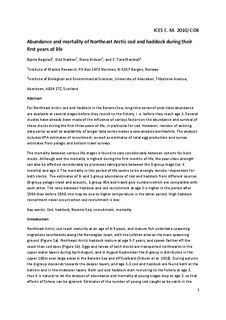Abundance and mortality of Northeast Arctic cod and haddock during their first years of life
Working paper
Permanent lenke
http://hdl.handle.net/11250/102087Utgivelsesdato
2010Metadata
Vis full innførselSamlinger
Originalversjon
This report is not to be quoted without prior consultation with the General Secretary.Sammendrag
For Northeast Arctic cod and haddock in the Barents Sea, long time series of year-class abundance are available at several stages before they recruit to the fishery, i. e. before they reach age 3. Several studies have already been made of the influence of various factors on the abundance and survival of these stocks during the first three years of life, in particular for cod. However, revision of existing data series as well as availability of longer data series makes a new analysis worthwhile. The analysis includes VPA estimates of recruitment, as well as estimates of total egg production and survey estimates from pelagic and bottom trawl surveys.
The mortality between various life stages is found to vary considerably between cohorts for both stocks. Although and the mortality is highest during the first months of life, the year-class strength can also be affected considerably by processes taking place between the 0-group stage (ca. 6 months) and age 3. The mortality in this period of life seems to be strongly density –dependent for both stocks. The estimates of 0- and 1-group abundance of cod and haddock from different sources (0-group pelagic trawl and acoustic, 1-group XSA and trawl) give numbers which are compatible with each other. The ratio between haddock and cod recruitment at age 3 is higher in the period after 1980 than before 1980, this may be due to higher temperature in the latter period. High haddock recruitment never occurs when cod recruitment is low.
